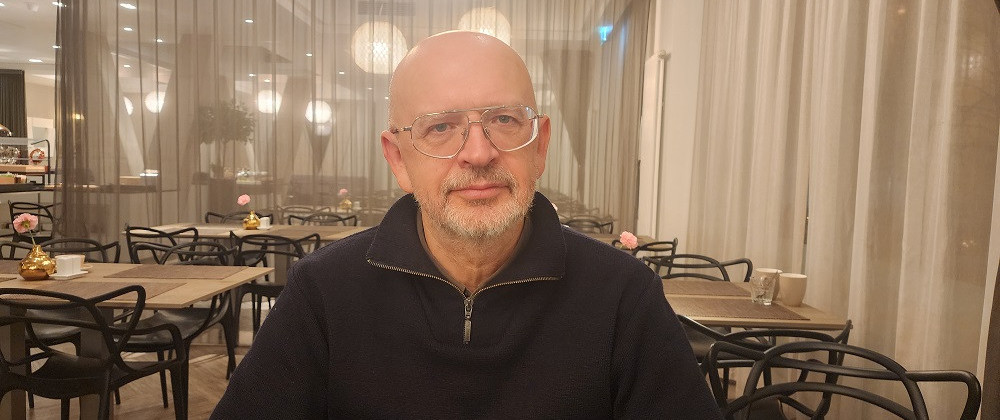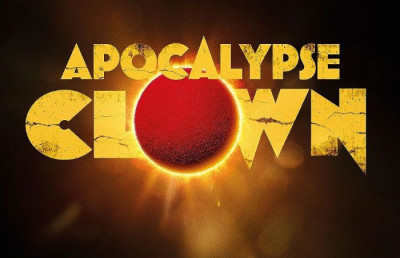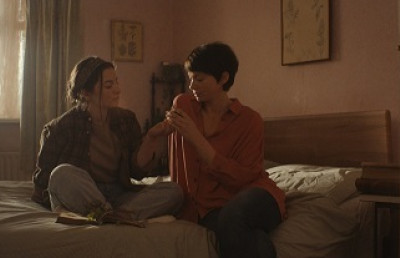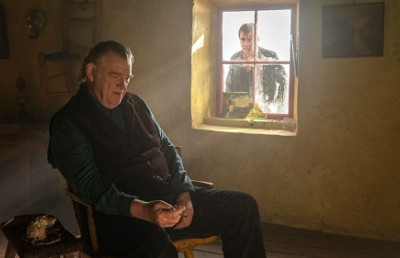PӦFF (Tallinn Black Nights Film Festival ) Interview: Director Deimantas Narkevičius on Twittering Soul

Director Deimantas Narkevičius (photo source, Joshua Polanski)
Very rarely does a screening of a film become an essential cinephile event. But for both its challenging originality and availability, every screening of Twittering Soul, the first-ever Lithuanian fiction film to make use of stereoscopy, should be considered a de facto event for local cinephiles. Set in the nineteenth century, two traveling musicians discern what life after death might look like, a rich landowner obsesses over stereoscopic images, and well-intended witches are part of everyday life in this mundane-fantasy shot in the all-but already fantastical South Lithuanian countryside.
Keeping true to his artistic integrity, director and reputable multi-modal artist Deimantas Narkevičius has no intentions of ever releasing the film in standard 2-D. And with the lack of 3-D programming, especially at the single screen and arthouse theaters most likely to show a Lithuanian non-genre conforming film in the first place, it seems unlikely to ever receive a wide release in the United States and any hopes for physical distribution just seems fantastical. (Distributors and exhibitors, prove me wrong.) To watch 3-D films as intended, one needs access to either high-quality projectors or virtual reality equipment—both of which are serious economic investments with limited opportunities for capitalization in the first place (How often does a Resident Evil: Retribution come out?). So, for scarcity reasons alone, any and every screening of Twittering Soul should be considered a cinephile event of the same scale as (any) 70mm repertoire programming or a new Park Chan-wook release. In truth, most interested viewers, regretfully, will never even have the opportunity to catch Narkevičius’s great and ineffable film.
Such a screening would be a different movie, as he told me in our conversation in Tallinn. And he’s right. He toys around with the size of his subjects like action figures and creates a fantastical immersion out of plain scenery in a manner unique to the 3-D format, unreplicable in standard formats or in any other art form for that matter, making them essentially cinematic. Most importantly, in an age when the vast majority of 3-D theatrical screenings are reserved for anti-art Marvel post-conversions, the artfully layered depth of every composition in Twittering Soul comes across as completely novel, even formally revolutionary. In a movie like Ant-Man and the Wasp: Quantumania, there are two planes: the foreground with the lead characters and the flat background with little more texture than a computer wallpaper. Narkevičius’s first feature (though, he has experimented with stereoscopic technology in the short film format), tests the possibilities of the three-dimensional format as something with the potential to expand the cinematic canvas rather than produce cheap thrills and theatrics of flying objects.
Twittering Soul was designed for stereoscopy (a term Narkevičius preferred over “3-D” in our interview) and every frame makes that apparent. When the camera peers at characters meandering in the wilderness through a gap in foliage, it does so through a gap in the tree leaves that comes alive and obscures or clarifies details at different depth levels of the composition. It’s such a simple shot, mundane really, but it’s also unlike most adjacent shots in generic filmmaking where the gap in the foliage would merely be a window onto the subjects rather than making the landscape itself something magical in the process, which, in turn, dramatically reorders how the viewer perceives the subjects.
I would caution against cornering the film as a longer and more ambitious attempt to bring installation video art to a larger audience. This is not simply installation art designed from the beginning as incomprehensible intellectualism. Twittering Soul, as demanding as it may be, is not incomprehensible nor fundamentally intellectual. If anything, it’s primarily experiential; what moves and what compels are the meticulously directed visuals (and the intensely emotional and culturally specific score), which barely require linguistic translation. The funeral scene is one of the most moving film funerals I’ve seen in part because of the diegetic overperformance of grief by the departed’s friend, and in part because of the submersion of the visuals. As the loud wailing moves beyond an ethnographic interest and into something more primal, the casket pushes into a plane of magical space made possibly only through the illusion of stereoscopy. The scene’s big emotions succeed because they are an aesthetic experience, not an intellectual one. It’s not the first meaningful use of stereoscopy nor will it be the last, but like the screenlife films of Timur Bekmambetov, Twittering Soul is an exemplar of innovation.
Read Joshua Polanski’s review of Twittering Soul in the latest issue of Offscreen. The interview, conducted at the Nordic Hotel in Tallinn, Estonia at the Tallinn Black Nights Film Festival (PӦFF), has been condensed and edited for clarity.
Offscreen: Can you describe the artistic origins of the film? Where did the original idea come from?
Deimantas Narkevičius: There are different sources.
First of all, I think, it comes from a dissatisfaction with the rational way of life. Our world was so logical, I was so logical: thoughts about how the economy could be improved or how our social setup could be better, and so on. Around 2014-15, I thought to myself that something was going wrong. The state of our ecology, politics becoming really extreme and divisive and weird… especially in Central Europe. There's something not very logical [to all this].
The world is kind of falling apart again like in the beginning of the 1990s when I was still studying, but in a different way, and I thought maybe I should do something about this, something critical of the contemporary. So I return to this kind of folklore or local mythology and to the times before the technological revolution when people were still dependent on the environment and nature: agriculture, the seasonal orientation of time, harvesting. They were looking at nature and depended on it, but there was also a lot of mythology through centuries to be careful with nature and take care of it. I thought maybe [Twittering Soul] could be a nice way to address this. I want to be careful about saying this, but it's kind of a European ingenuity.
Offscreen: How so?
DN: After the end of these 100-plus years, we are in the same [mode of] imperial thinking. There’s war in Europe when we never thought it would happen again. [Europe is] politically destabilized, the economy is uncertain and unstable, and how we relate with nature has changed [drastically] in the last few decades. Even now we don’t see it, especially in Lithuania, and so I thought let's return to our mythology. We know that people were aware that they didn’t understand the world, the surroundings, nature, the world, or God. It's very unexpected and you are weak towards nature because it's much stronger than you.
I'm not an anti-modernist or something, though.
Offscreen: You’ve mentioned mythology a few times. What are the myths you have in mind?
DN: Well, they're not myths like the canonized Greek or Indian myths. Compared to other national mythologies, our stories are also a little bit lost. We don’t have this sort of clear recorded form of what religion was precisely before Christianity.
The countryside life in Lithuania, I would say, was very conservative and there were very strong communities. After the mid-20th century, there was limited interaction until communism and collectivization started. [1]
People were always singing. They wake up, feed their cattle or something, and start singing. It was the form of communication. I still remember that at that time, in the early 70s, people were not so much singing outside but inside. They were singing for themselves.
It was really a bit like in the film, singing that [the animals will not get sick and so on]. There was this kind of complicated system, but the main meat I use are youth songs about love. My funeral scene is very much like a wedding as well because there are many similarities. Both are about leaving for another world.
It's all about leaving, what is unknown, and, [in your mind,] setting up your cosmogonical universe so that you are still in control of the situation—maybe one looks to the stars or the moon or sun or [God] to give that control. That is something universal and basic that anyone can relate to. The universe and the environment become humanized or anthropomorphized.
Offscreen: You began as a sculptor, if I’m correct, but primarily work in film. Do you think of yourself first and foremost as a filmmaker?
DN: It's my first feature film. Within the art scene, [by contrast], I am three decades in. My first participation in film festivals was already more than two decades ago, I think, with Rotterdam and Oberhaus, and I did show my films, which I didn't consider to be film work, but they were filmed on celluloid and digitized, or not. A few years later, I had a short program of my work at the Rotterdam film festival and Berlinale.
Offscreen: Your film struck me with its innovative stereoscopic design. Instead of objects cheaply flying in the face of the viewer, you seemed to use stereoscopy to open up your artistic canvas with compositional depth. With the layered compositional complexity of each frame, Twittering Soul feels as if the film was designed primarily for 3-D. Was this the case?
DN: Oh, from the very beginning…from the very beginning. I did some short films in 3D, films that I showed mainly as installations in galleries, so I [was familiar with the technology] and I knew abouts its effects. From the very beginning, it was very clear that it had to be stereoscopy and only stereoscopy; there were never any other options. You're not going to show it in 2D, no, that would be another film.
Stereoscopic filming uses a rig and it’s very static in a way because you cannot fly with a drone or have any fancy camera movements. It's very simple. It's a filmmaking [style] from the 80s years ago: the camera can move up-down and left-right and that's it. No zoom [and no tracking]. The stereoscopic illusion adds another dimension and perception to how you see the film, how you arrange the scenes, and how you edit. But if shown in 2D, it would just look boring. What is this, a costume drama or whatever? Many would question why it is so slow too. Why is it so old-fashioned in a way? Stereoscopy is the only format for Twittering Soul.
Offscreen: And you don't think there will be any pressure from your producers on a 2D release?
DN: No, we have agreed on that. I would say I’m really distracted [because], we have heard that even here, some jury members are not going to the cinemas because they prefer to watch the films at home. [My film] is not available though, it’s not supposed to be.
I met [with someone] in Vilnius for the Venice Film Festival and they told me to submit the film. But they said, “I'm only one of the five and honestly, we are all on different continents so all watch the films digitally.” And we can't do this for our film. This is just one example too. It's very very difficult to get into festivals to make programmers or even the jury receive the film. They are just tired and they want to sit quietly from home, and so on.
We are releasing the film shortly in Lithuania cinemas. Of course, we would love to screen it in as many places as possible, but again, we have these technical barriers. If some cinemas would show it anyway, I think people would get an exceptional experience. Maybe the content will not be very easy for them all, but it's not supposed to be easy. It's supposed to be an experience.
Offscreen: It’s not an easy film.
DN: So many films are produced every year and so good films, so I tried to make mine a little bit different with the content, the way it’s made, and even how it’s accessible. Different but also still accessible.
I didn't want to be radical. After the film, I didn’t want viewers to feel pain in their eyes [or something like that]. I just wanted to provide a pleasant 70-minute experience and, at the same time, the film demands a lot from the viewer to try to understand and to read and to see what's going on.
Offscreen: How long did production take?
DN: With the development, about three and a half or four years. The stereoscopy also took us more than a year of post-production.
Offscreen: There is a lot of magic in Twittering Soul but it’s so very mundane—and I mean that in a good way. Magic is just part of the world, and it’s basically neutral—neither good nor bad. The Latvian film Upurga did something similar in 2021. Do you think of this as part of the Baltic past?
DN: It’s a bit different in Latvia. The [exploration] of the pre-Christian past is promoted in a way by the state, and they take it very seriously. So, Latvia has a very different history. I don't know if this is the trend in Lithuania, and my film is very untrendy.
When I was saying to some people, “I’m making a fairy tale and it's kind of based on the sort of bits of Lithuanian mythology,” they ask, “What is wrong with you? We have so many other [modern] issues?”
In four days, we will have our Lithuanian premiere. I don't know what's going to happen. I know that it's sold out.
Offscreen: Your funeral scene was one of the most original I’ve seen. Can you speak of what it was like to film this scene?
DN: Thank you. The cinematographer and I had to calculate and arrange how to set up this levitating [dead] person. Of course, she was on the table with wheels, but we also had to film the scene without the body so that it would be possible to cover in the post-production. In a way, it was very carefully directed and very carefully selected.
At the same time, we had a person who was stuck in this archaic mourning crying…When I was young, this [ecstatic mourning ritual] was still alive—the earth will eat you or something. This unbearable, emotional [performance]. It's just so strange, but it's not around so much anymore… She was 23 years old at that time and she's prepared herself for weeks from this act because it's very emotional and it’s very difficult. Even she wanted to see the person in advance and asked about how the scene would be filmed. On the one hand, it was very planned and precise. At the same time, our one actor is in an improvisational and very emotional state. That was really challenging for me to manage.
Offscreen: I thought of Vermeer while watching your film, especially in the interior scenes of the home: the busyness, the colors, the wardrobes, and the compositional layers. Were the paintings of Vermeer an influence on Twittering Soul?
DN: I love Vermeer. In a way, [his paintings] are very cinematic. [But] no, he wasn’t directly. But I come from visual arts studies and you can't pass through without Vermeer or El Greco and then the later modernists.
I love to see Vermeer paintings in person, though I guess there aren’t many. Whenever you go to a museum and there's a Vermeer, it's a big deal.
Vermeer, I think in general, is influential for cinematographers. I don't know, maybe I was not particularly thinking of his paintings when I was arranging this film, but Vermeer has been one of my longest interests since I was studying and is one of my most beloved artists to come across in old collections. In general, I love Flemish or Old Dutch paintings from around the 16th century, especially when they are still in their original places.
Offscreen: That comes across in the coloring of the film.
Yeah, I was quite often going to Brussels to enjoy the paintings… As a contemporary artist and politically oriented leftist, you know, people would judge me for [this]. But there’s a lot of quality. These Flemish artists depict [biblical creation] to see the world in the present. And I think even this religious sense is so much about biblical times, it may be an excuse, but it's not about biblical times.
I think what I like [appreciating traditional art] is there's no canonical way to sing or to cry or to be sad or to be happy. It's all very individual. Of course, you know what to say and you learn from each other, but it's not that you go on the stage and perform something. It's really an individualized experience within a certain artistic tradition. But it's not a canon. This tradition is alive. So this interests me.
Offscreen: In a hypothetical world in which you can make everyone in the world watch three films, what three would you pick?
DN: Oh my God, I don't know. The first that comes to mind is Alexander Dovzhenko’s Earth (1930).
Also, Dr Zhivago (1965). Even though it was made in Hollywood, I think it's a very nice film. You see the artificialness, how they imagine the Russian world as well, especially for me who speaks nearly perfect Russian, but still it’s very beautifully created. The quality of creativity was somehow still important during these terrible, anti-human times. This compensates for a lack of knowledge of Russian life. It's beautiful, but it's beautiful because it's lifted up from Russian society. It's really like it's made like another world, a hypothetical Russian world. It's beautiful.
I don't know. There are so many films, so many films. [Giggling,] I love Life of Pi (2012). It’s a very philosophical film.
Offscreen: Very interesting third choice. Not unlike Twittering Soul in that it blurs the distinction between reality and dream worlds.
DN: I watched the film in stereoscopy as well. It was one of the best stereoscopic films.
Offscreen: What’s next?
DN: I don't know. There are some ideas, of course, but probably it's too early to talk about. I still want this film to go out and [hopefully be well received.] As we started at the beginning, even technically it's not easy to present, [so my focus is on this film right now].
It would be great to show it at even bigger festivals, but they're difficult to get into. How do you present it? 2D doesn't work because of the surrealism of the landscape; the optics make little changes in the proportions and the visual experience. It's part of the magic. And when that’s taken away, it isn’t that interesting anymore.













